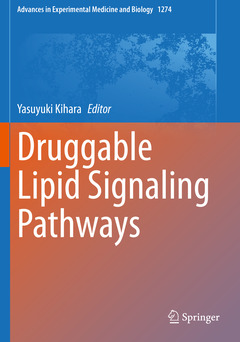Druggable Lipid Signaling Pathways, 1st ed. 2020 Advances in Experimental Medicine and Biology Series, Vol. 1274
Coordonnateur : Kihara Yasuyuki

Lipids are responsible not just for constituting cellular membrane but also for storing energy, transducing signaling, and modifying proteins. Bioactive lipids, or lipid mediators, transduce signaling as intracellular messenger like phosphoinoitides, and also regulate cell-cell communication through G protein-coupled receptors (GPCRs) that are potentially valuable drug targets in many diseases. Until now, about 40 GPCRs within ~300 rhodopsin-like (class A) GPCRs, are identified as lipid GPCRs. Advances of lipid research have enabled to develop novel small molecules targeting lipid GPCRs for several diseases. Most notably, fingolimod (FTY720), a sphingosine 1-phosphate (S1P) receptor modulator, became the first FDA-approved medicine as an orally bioavailable drug for treating relapsing forms of multiple sclerosis (MS). In addition to fingolimod, other drugs targeting lipid GPCRs had been developed such as latanoprost (prostaglandin F2a analogue, used for ocular hypertension and glaucoma), epoprostenol and treprostinil (prostaglandin I2 analogue, used for pulmonary arterial hypertension), montelukast and pranlukast (cysteinyl leukotriene receptor antagonist, used for asthma and allergies), etc. Novel drugs are also expected like lysophosphatidic acid (LPA) receptor antagonist for treatment of pulmonary fibrosis.
Drug development targeting lipid signalling pathways are backdated to more than a century, when aspirin was synthesized and selling by Bayer, while the basic mechanism of aspirin's effects (block prostanoid synthesis by inhibiting cyclooxygenases) had not been discovered until 1970s. Nowadays, non-steroidal anti-inflammatory drugs (NSAIDs) like aspirin and ibuprophen are commonly used as antipyretic analgesics and available readily over-the-counter oral drugs. Both upstream and downstream enzymes, such as phospholipase A2s and prostaglandin E synthases, respectively, are also potential therapeutic targets for inflammatory diseases.
Recent studies of lipid metabolism expand the lipid biology field from pro-inflammatory lipid mediators to anti-inflammatory epoxy fatty acids (epoxyeicosatrienoic acids), and also omega-3 fatty acid-derived pro-resolving lipid mediators (lipoxin, resolvin, and neuroprotectin). These bioactive lipids, their metabolic pathways and receptors are of great interest in developing next-generation anti-inflammatory and pro-resolving drugs for a wide variety of diseases including.
This book summarizes not only historical overview of lipid signaling pathways but also provides summary of cutting-edge studies that may provide some hints of novel ?druggable? lipid signaling targets.
Preface.- Introduction of Druggable Lipid Signaling Pathway.- Biosynthetic Enzymes of Membrane Glycerophospholipid Diversity as Therapeutic Targets for Drug Development.- Druggable Prostanoid Pathway.- Targeting Leukotrienes as a Therapeutic Strategy to Prevent Comorbidities Associated with Metabolic Stress.- Epoxy Fatty Acids are Promising Targets for Treatment of Pain, Cardiovascular Disease and Other Indications Characterized by Mitochondrial Dysfunction, Endoplasmic Stress and Inflammation.- Druggable Sphingolipid Pathway.- Druggable Lysophospholipid Pathway.- Druggable targets in endocannabinoid signaling.- Drugging the phosphoinositide 3-kinase (PI3K) and phosphatidylinositol 4-kinase (PI4K) family of enzymes for treatment of cancer, immune disorders, and viral/parasitic infections.- Druggable Lipid GPCRs: Past, Present, and Prospects.
Date de parution : 09-2021
Ouvrage de 260 p.
17.8x25.4 cm
Date de parution : 09-2020
Ouvrage de 260 p.
17.8x25.4 cm
Thèmes de Druggable Lipid Signaling Pathways :
Mots-clés :
lipids; GPCR; drug discovery; disease; translational research



